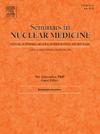New Targets for Imaging in Nuclear Medicine
IF 5.9
2区 医学
Q1 RADIOLOGY, NUCLEAR MEDICINE & MEDICAL IMAGING
引用次数: 0
Abstract
Nuclear medicine is rapidly evolving with new molecular imaging targets and advanced computational tools that promise to enhance diagnostic precision and personalized therapy. Recent years have seen a surge in novel PET and SPECT tracers, such as those targeting prostate-specific membrane antigen (PSMA) in prostate cancer, fibroblast activation protein (FAP) in tumor stroma, and tau protein in neurodegenerative disease. These tracers enable more specific visualization of disease processes compared to traditional agents, fitting into a broader shift toward precision imaging in oncology and neurology. In parallel, artificial intelligence (AI) and machine learning techniques are being integrated into tracer development and image analysis. AI-driven methods can accelerate radiopharmaceutical discovery, optimize pharmacokinetic properties, and assist in interpreting complex imaging datasets. This editorial provides an expanded overview of emerging imaging targets and techniques, including theranostic applications that pair diagnosis with radionuclide therapy, and examines how AI is augmenting nuclear medicine. We discuss the implications of these advancements within the field’s historical trajectory and address the regulatory, manufacturing, and clinical challenges that must be navigated. Innovations in molecular targeting and AI are poised to transform nuclear medicine practice, enabling more personalized diagnostics and radiotheranostic strategies in the era of precision healthcare.
核医学成像新靶点。
核医学正在迅速发展,新的分子成像目标和先进的计算工具有望提高诊断精度和个性化治疗。近年来,新的PET和SPECT示踪剂出现了激增,例如针对前列腺癌中的前列腺特异性膜抗原(PSMA)、肿瘤基质中的成纤维细胞激活蛋白(FAP)和神经退行性疾病中的tau蛋白的示踪剂。与传统药物相比,这些示踪剂能够更具体地可视化疾病过程,适应肿瘤和神经病学向精确成像的更广泛转变。与此同时,人工智能(AI)和机器学习技术正在被整合到示踪剂开发和图像分析中。人工智能驱动的方法可以加速放射性药物的发现,优化药代动力学特性,并协助解释复杂的成像数据集。这篇社论提供了新兴成像靶点和技术的扩展概述,包括将诊断与放射性核素治疗相结合的治疗应用,并研究了人工智能如何增强核医学。我们将讨论这些进展对该领域历史轨迹的影响,并解决必须解决的监管、制造和临床挑战。分子靶向和人工智能的创新将改变核医学实践,在精准医疗时代实现更个性化的诊断和放射治疗策略。
本文章由计算机程序翻译,如有差异,请以英文原文为准。
求助全文
约1分钟内获得全文
求助全文
来源期刊

Seminars in nuclear medicine
医学-核医学
CiteScore
9.80
自引率
6.10%
发文量
86
审稿时长
14 days
期刊介绍:
Seminars in Nuclear Medicine is the leading review journal in nuclear medicine. Each issue brings you expert reviews and commentary on a single topic as selected by the Editors. The journal contains extensive coverage of the field of nuclear medicine, including PET, SPECT, and other molecular imaging studies, and related imaging studies. Full-color illustrations are used throughout to highlight important findings. Seminars is included in PubMed/Medline, Thomson/ISI, and other major scientific indexes.
 求助内容:
求助内容: 应助结果提醒方式:
应助结果提醒方式:


